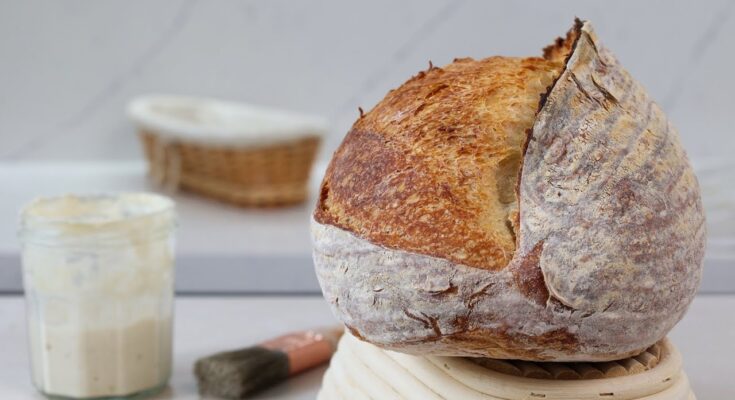Sourdough Recipe: Sourdough baking is an ancient craft that has stood the test of time, celebrated for its rich flavors, chewy texture, and health benefits.
Unlike regular bread, sourdough is made with a natural starter instead of commercial yeast, making the process both artful and rewarding. It’s not just baking; it’s a journey where each loaf tells a story.
Ready to dive in? Let’s break it down step by step.
Ingredients Needed for Sourdough Bread
To make sourdough bread, you need just a few basic ingredients, but each one plays a crucial role.
Core Ingredients:
- Flour: Unbleached bread flour is best for beginners.
- Water: Filtered or spring water for better fermentation.
- Salt: Fine sea salt enhances flavor.
Optional Add-ins:
- Seeds, herbs, or dried fruit to add unique flavors.
These simple ingredients come together to create magic, thanks to the fermentation process.
Essential Tools for Sourdough Baking
While sourdough can be rustic, having the right tools makes the process easier and more enjoyable.
Must-Have Tools:
- Digital scale (precision is key!)
- Large mixing bowl
- Bench scraper
- Proofing basket or bowl with a towel
- Dutch oven or baking stone
Beginner Alternatives:
Don’t have a proofing basket? Use a clean kitchen towel in a bowl. No Dutch oven? Bake on a tray with a pan of water underneath for steam.
Preparing Sourdough – Step-by-Step Guide
Step 1: Making Your Sourdough Starter
The starter is the heart of sourdough baking. It’s a mix of flour and water that ferments over days, cultivating wild yeast and bacteria.
How to Make a Starter:
- Combine 50g flour with 50g water in a jar. Mix well.
- Leave it uncovered for an hour, then cover loosely.
- Feed daily (same ratio of flour and water) for 5–7 days.
Tips for Maintenance:
Once active, refrigerate and feed weekly. A healthy starter smells tangy and bubbles vigorously.
Step 2: Preparing the Dough
Now that your starter is alive, it’s time to make the dough.
Ingredients:
- 500g bread flour
- 350g water
- 100g active starter
- 10g salt
Process:
- Mix flour and water; let rest (autolyse) for 30 minutes.
- Add salt and starter; mix until combined.
- Knead briefly or use the stretch-and-fold method for a more gentle approach.
This stage sets the foundation for the bread’s structure and flavor.
Step 3: Bulk Fermentation
Bulk fermentation is where the magic begins. During this stage, the dough rises and develops flavor.
Steps:
- Place the dough in a greased bowl.
- Cover and let it rest at room temperature for 4–6 hours.
- Perform stretch-and-fold every 30 minutes for the first 2 hours.
Key Tips:
The dough should double in size, feel airy, and pass the “poke test” (lightly press it; the indentation should spring back slowly).
Step 4: Shaping the Dough
Shaping is a critical part of sourdough baking that determines the bread’s final structure and appearance. It might seem daunting at first, but with practice, it becomes second nature.
How to Shape the Dough:
- Lightly flour your work surface to prevent sticking.
- Turn the dough out onto the surface without deflating it.
- Pre-shape it into a round by gently folding the edges toward the center. Let it rest for 20–30 minutes.
- Perform the final shaping: pull the dough tight into your desired shape (round or oval), ensuring tension on the surface.
Pro Tips:
- Use a bench scraper for precision.
- Handle the dough gently to preserve the air bubbles created during fermentation.
Step 5: Proofing the Dough
Proofing is the final rise of the dough before baking, where it develops additional flavor and structure.
Cold vs. Room Temperature Proofing:
- Room temperature proofing takes 2–4 hours.
- Cold proofing in the refrigerator can last up to 24 hours, enhancing the flavor.
How to Tell When It’s Ready:
- Perform the “poke test.” If you press a finger into the dough and the indentation springs back slowly, it’s ready to bake.
- Look for a puffed-up appearance but avoid over-proofing, as it can lead to a flat loaf.
Step 6: Scoring the Dough
Scoring is both functional and artistic. It allows steam to escape during baking and controls the loaf’s expansion.
Steps for Scoring:
- Turn the proofed dough onto parchment paper or directly into a Dutch oven.
- Use a sharp blade or lame to cut shallow slashes in the surface.
- Keep it simple or experiment with patterns like leaves, hearts, or spirals.
Why It Matters:
Proper scoring prevents random bursting and creates that iconic artisan look.
Step 7: Baking the Bread
Now, the moment you’ve been waiting for: baking your sourdough! This step transforms your dough into a golden, crusty loaf.
Ideal Oven Settings:
- Preheat your oven to 450°F (230°C) with a Dutch oven or baking stone inside.
- Bake covered for the first 20–25 minutes to trap steam.
- Remove the lid and bake for another 20–25 minutes until the crust is deep golden brown.
Creating Steam:
If you don’t have a Dutch oven, place a pan of boiling water on the oven’s lower rack during the first half of baking. Steam enhances the crust’s texture and shine.
Step 8: Cooling and Slicing the Bread
It’s tempting to dive right in, but cooling is essential to complete the baking process.
Why Cooling is Important: Cooling allows the crumb (interior) to set and prevents a gummy texture.
Best Practices:
- Let the bread cool on a wire rack for at least 1–2 hours.
- Use a serrated knife to slice, ensuring clean cuts without squishing the bread.
Common Issues and Fixes in Sourdough Baking
Even experienced bakers encounter challenges. Here’s how to tackle common issues:
Dense Loaf:
- Likely due to under-proofing or insufficient kneading.
- Solution: Allow more time during bulk fermentation or proofing.
Over-proofing:
- Signs: Dough collapses or spreads too much.
- Solution: Shorten proofing time and refrigerate sooner.
Tips for Perfect Sourdough Bread
Mastering sourdough takes practice, but these tips can elevate your baking:
- Adjust Hydration Levels: Higher hydration (more water) yields a more open crumb but requires careful handling.
- Use Quality Flour: Organic, unbleached flours with high protein content produce the best results.
- Temperature Control: Fermentation is temperature-sensitive. Keep your kitchen warm or adjust proofing times accordingly.
Creative Variations of Sourdough Bread
Once you’ve mastered the basics, try experimenting with flavors and ingredients:
Add-ins:
- Mix in herbs like rosemary or thyme for a savory loaf.
- Add seeds, nuts, or dried fruit for texture and sweetness.
Alternative Flours:
- Swap some bread flour for whole wheat or rye for a denser, heartier bread.
- Adjust hydration, as whole grains absorb more water.
FAQs about Sourdough Recipe
1. What is sourdough?
Sourdough is a type of bread made using natural fermentation, combining flour and water to create a live culture known as a starter. This starter gives sourdough its signature tangy flavor and airy texture.
2. How do I make a sourdough starter?
To make a sourdough starter, mix equal parts of flour and water in a clean jar and leave it at room temperature. Feed the mixture daily with fresh flour and water for 5–7 days until it bubbles and smells tangy.
3. Can I make sourdough without a starter?
No, a sourdough starter is essential for the fermentation process, which creates the bread’s rise and flavor. You can, however, buy a starter or get one from a friend to skip the creation step.
4. Why is my sourdough not rising?
This could be due to an inactive starter, improper kneading, or insufficient proofing time. Ensure your starter is bubbly and active before baking, and allow the dough to proof in a warm environment.
5. Can I freeze sourdough bread?
Yes, sourdough bread freezes well. Wrap it tightly in plastic or foil and store it in a freezer bag. Thaw at room temperature before serving.
6. Is sourdough healthier than regular bread?
Sourdough is considered healthier because its natural fermentation helps break down gluten and improves nutrient absorption. It may also be easier to digest for some individuals.
7. How long does homemade sourdough bread last?
Homemade sourdough bread typically lasts 3–4 days at room temperature if stored in an airtight container or bread box. For extended freshness, refrigerate or freeze it.
Conclusion
Baking sourdough bread is a rewarding experience that combines science, art, and patience. Each loaf is a testament to your effort and creativity, offering flavors and textures far superior to store-bought bread. Whether you’re a beginner or an experienced baker, the journey of sourdough is always evolving. So grab your starter, flour, and tools, and start baking your masterpiece today!



